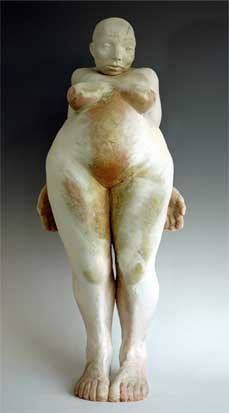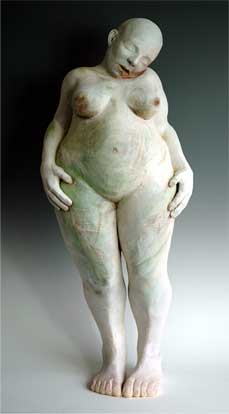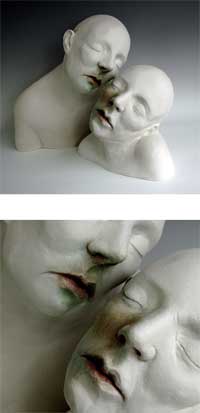 |
||
FRAGMENTED FIGURE |
| |
|||||||||||||||||
Natasha Mayo Exhibited Works |
|||||||||||||||||
|
|||||||||||||||||
| |
|||||||||||||||||
Fragmentation in Natasha Mayo’s Ceramicsby Natasha Mayo
|
|||||||||||||||||
|
Fragmentation is not immediately evident in Mayo’s full and rounded female forms. It is the surface of the body, qualities of flesh and skin, that reveals an essentially fragmented nature. Skin is considered not simply as containing the body – keeping in and keeping out -– but as breathing, absorbing and emitting; its properties defined by continual interaction between the body and its environment. Herein lies the notion of fragmentation, neither impermeable whole nor broken pieces but a subtle dialectic between states; a membrane exposed to, and exposing of our predicament. The faces in ‘Breathe’ appear flushed. Their skin hue and tone has been rearranged from its usual order in nature to suggest the particular intensity and orientation of sensations experienced through the flesh in response to physical attraction, that heightened sense of proximity to another, the tingling almost tugging sensation of skin as blood floods its outermost layers. In this work, prominence is given to the tendency of colours to move forward or recede in the activity of our perception, so that warmer tones emerge at the forefront of our vision, flushing their cheeks as if in response to each other. This activity is particularly evident when placed next to blues and paler colours that recede and cover their remaining surface. Reflective and absorbent qualities are also used to further the sense of skin reacting to and revealing sensation; the reflective area around their cheeks, nose and mouth suggests a thinner layer, exposing deeper colours from beneath the skin. These effects are not merely optical but forge correspondence with emotional states felt as if in response to this activity, feelings of embarrassment, vulnerability or tenderness. The surface evokes such intimacy between the figures that the warmth of his breath might be felt and absorbed through her delicate soft flesh.1 The medium of ceramic has the potential to expressively render flesh and skin, and reveal the close association between skin and the expression of thought. There is even a sense in which, when blushing, paling, sweating or registering fear, grief or shame that we are, albeit momentarily, taken over by its conveyance of emotion before we are consciously aware of our own feelings, what Connor describes as ‘thinking through the skin’2. Mayo examines this capacity of the surface of the body, exploring Anzieu’s definition of ‘skin as a locus of thinking, a site from which thinking takes place and onto which thought is projected’3. Notes1. Mayo examines the expressive potential of colour to prompt both emotional states and physical sensations in her PhD thesis: An Investigation into the Potential of Ceramics to Expressively Render flesh and Skin on the Human Body, University of Wales, 2003. Her thesis examines and applies Merleau-Ponty's theories of phenomenology to our perception of figurative work, Merleau-Ponty, M., Phenomenology of Perception, trans. Smith, Routledge & Keegan, 1962. back to text 2. Connor, S., The Book of Skin, Cornell University Press, 2004, p. back to text 3. Anzieu, D., Cited in: Prosser, J., Second Skin: The Body Narratives of Transsexuality, New York: Columbia University Press, 1998, p. 73. back to text
|
|
Recommended Reading Published on ICRC: Brenda Schmahmann: Mary Drach McInnes:
|
|||||||||||||||
| |
|||||||||||||||||
| University of Wales Intitute, cardiff | Adorfa Prifysgol Cymru, Caerdydd | |||||||||||||||||



